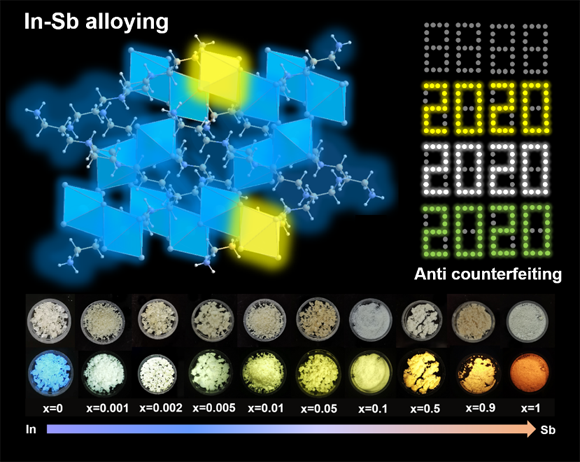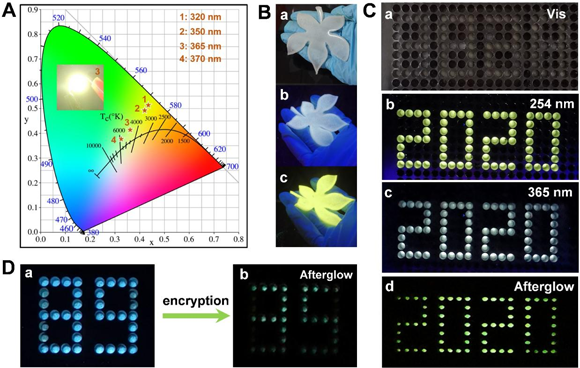Professor Kuang Dai-Bin’s team: Indium-antimony-halide single crystals for high-efficiency white-light emission and anti-counterfeiting
Source: School of Chemistry
Edited by: Tan Rongyu, Wang Dongmei
The single-source white light emitting material has been highlighted with excellent color stability and can efficiently avert self-absorption issues faced by the currently commercial multicomponent-based white-light sources. Benefiting from lowering the structural dimensionality of metal halide single crystal from 3D to 2D, 1D, or 0D, the soft lattice and structural confinement facilitate free excitons (FEs) to be confined in inorganic polyhedron, thus in favor of the formation of self-trapped excitons (STEs), which usually exhibit a broadband emission even covering the whole visible spectrum. In addition, the coexistence of FEs and STEs enables the low-dimensional lead halide perovskites to attract dual-band or multiband emission behaviors, which as a result gives rise to white emission. Although some single-source white metal halide light-emitting single crystal materials have been reported, the design and synthesis of lead-free metal halide single crystal with high luminous efficiency is still challenging.

Figure 1. The crystal structure and images of BAPPIn
2-2xSb
2xCl
10 single crystals.
Recently, on the basis of previous research of indium-based halide luminescent single crystals (
Angew. Chem. Int. Ed. 2019, 58, 5277 –5281;
Angew. Chem. Int. Ed. 2019, 58, 15435 – 15440), Professor Kuang Dai-Bin’s team from the School of Chemistry at Sun Yat-sen University reported a new type of organic-inorganic hybrid indium-antimony bimetallic halide single crystal. By elaborately selecting the organic cation, the family of BAPPIn
2–2xSb
2xCl
10 (BAPP = C
10H
28N
4,x = 0 to 1) single crystals exhibit tunable emission. Intensive blue emission is observed in BAPPIn
2Cl
10 under UV light excitation at 365 nm. As the alloyed Sb content gradually increases from 0 to 90%, the emission color could be tuned from original blue to white, yellow, and orange (Figure 1). Intriguingly, when trace amount of 0.2% Sb is alloyed, bright yellow emission with near 100% photoluminescence quantum yield (PLQY) is yielded when it was excited at 320 nm, which turns into bright white-light emission with a PLQY of 44.0% when excited at 365 nm. Moreover, the interesting afterglow behavior, together with excitation-dependent emission property, makes BAPPIn
2–2xSb
2xCl
10 as high-performance anti-counterfeiting/information storage materials. Figure 2 displays a confusing pattern encrypted with BAPPIn
2Cl
10 and BAPP-4HCl powder, which presents number “89” upon excitation at 365 nm but evolves into “35” as light turns off due to the faster afterglow decay of BAPP-4HCl than BAPPIn
2Cl
10, providing the opportunity to realize temporal anti-counterfeiting without the use of any complex time-gating technology. The report of BAPPIn
2–2xSb
2xCl
10 single crystals enrich the research of metal halide single crystals-based luminescent materials, and provide new ideas for the design and synthesis of single-source white-light emissive materials with multifunctional response.

Figure 2. The solid-state lighting and anti-counterfeiting applications of BAPPIn
2-2xSb
2xCl
10.
This work is recently published in
Science Advances. Professor Kuang Dai-Bin from the School of Chemistry at Sun Yat-sen University is the corresponding author of this paper, PhD candidate Wei Jun-Hua is the first author. This work is supported by the National Natural Science Foundation of China, the Guangdong Provincial Fundamental and Applied Basic Research Fund, and the Fundamental Research Funds for the Central Universities.
Link to the paper:
https://advances.sciencemag.org/content/7/34/eabg3989.full
